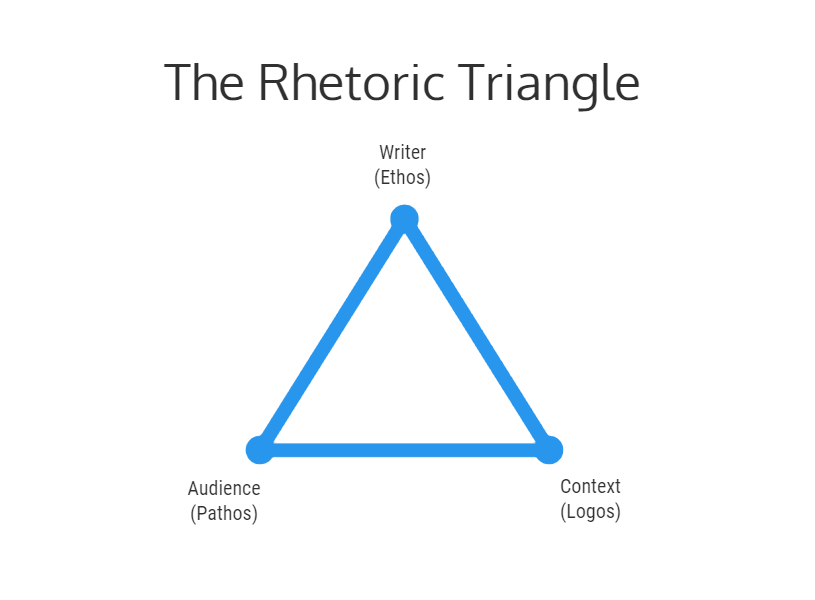All of these phenomenons fall under the umbrella of persuasive writing. Persuasive writing is one of the most common writing styles in the world. It’s also an art form. The main purpose of persuasive writing is to convince the audience that the opinion of the author is correct regarding a specific idea or set of ideas.
So what makes the Rhetorical Triangle?
The use of rhetoric within writing is an absolutely crucial step towards persuading the reader. The word rhetoric can be defined as a set of compositional techniques that writers use to fascinate readers. When used effectively, those reading will be able to fully connect with what’s being presented to them; they will clearly understand all the points and feel connected. The three sides of the Rhetorical Triangle correlate with a different impact point for the reader. In order to be a truly comprehensive writer, it’s important to account for each side of the triangle.
1. Ethos: the Writer
Whether or not your audience realizes it, they want to know your intentions as a writer. Comprehending a speaker’s motives is an instinctual desire for readers. It’s the writer’s job to make sure that what they project is concise and articulate. Are you trying to educate, inform, entertain, or motivate? Stating the intended purpose, from a writer’s standpoint, is a fundamental first step to effective writing. The audience is going to want to understand who you are as a writer. What makes you credible, and why should they listen to what you have to say? Furthermore, an LSU resource[1] explains the role of a writer’s ethos: “Ethos is what defines you as a writer and your character. It can be thought of as the role of the writer in the argument, how credible their argument is, as well as ethics.”
2. Pathos: the Audience
In order to write pieces that really resonate, writers must have a clear understanding of who exactly they are writing for. It’s important to ask yourself the following questions about an expected audience:
What is your audience expecting to hear from you? In what ways will your writing be useful/helpful to the intended audience? What similarities will an ideal audience share?
As a means of further connecting with an audience, the idea of pathos should be utilized. Pathos is the idea of gauging an emotional response within an audience. Ask yourself what emotions are ideal to instill. Do you want to tug at your reader’s heartstrings, or channel support by getting an audience excited or riled up?
3. Logos: the Context
Lastly, keep the context of any piece of writing in mind. Readers will view this with a critical eye and will be asking themselves questions, either implicitly or subconsciously. Keep in mind:
What other timely events, circumstances are relevant? What are all other sides and counter-arguments to your perspective? Is there outside evidence that supports claims made in your writing?
This all connects directly with the idea of logos, which relies on the extent of logical thinking within writing. A piece of writing that features clearly constructed points and intelligent insight will greatly appeal to an audience’s logos.
Man, it’s hard to follow the Rhetorical Triangle!
Addressing each side of the Rhetorical Triangle isn’t always easy and may require more attention to detail than you are used to. But it’s possible for anyone to produce engaging pieces of writing. In this case, the old adage is true: practice makes perfect. The more you think about each point of the triangle, the more second-nature this process will become.
Why is it so important to inject the Rhetorical Triangle into my writing?
There are countless reasons to always keep all sides of the Rhetorical Triangle in mind as a writer. First and foremost, your writing will fall short and not be credible if it doesn’t encompass each part of the triangle. And this must be done in a balanced fashion. For example, if a piece of writing is far too heavily focused on statistics and hard figures, but doesn’t offer any insight into why the author is credible or invoke any emotional responses, it may come off as robotic, lacking a “human quality.” Readers may become bored or become put off when writing only focuses on logos. Balancing each side of the Rhetorical Triangle is a must for effective writing. Whether writing is a career focus or side-hustle gig, there are many advantageous benefits for creating content that is well-shaped.[2] The steps to effectively including the Rhetorical Triangle are highlighted fully in an article titled The Rhetorical Triangle: Making Your Writing Credible, Appealing, and Logical:[3] Step One: Answer the audience’s question, ‘Is the source credible?’ Fully consider the impact your credibility has on your message. Failing to do so risks leaving your audience unconvinced. Step Two: Answer the audience’s hidden question, ‘Is this person trying to manipulate me?’ Fully consider your audience; otherwise they may feel disconnected and the message will be lost. Appeal to their emotions where this is appropriate and honest. Step Three: Answer the audience’s question, ‘Is the presentation logical?’ Fully consider the context of your message. And make sure you deliver it with a solid appeal to reason.” When you fully embrace and utilize these rhetorical strategies you’re writing will truly stand out.[4] You’ll become a more effective, marketable writer. You’re audience will connect with your work, and are much more likely to engage in comments sections and through social media shares.[5] A major reason that writers love what they do stems from the feelings of flexibility and how writing promotes work that is genuinely passionate. Listed as one of the top 5 work-at-home careers, writing (especially freelancer-driven writing) creates an atmosphere of workplace freedom.[6] With practice, anyone can work from home like a boss.[7] How would this impact your life? What would you do if you had total control of your schedule? How much or how little would you work in an ideal world?
